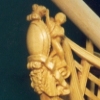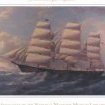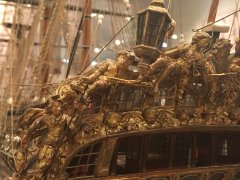-
Posts
2,213 -
Joined
-
Last visited
Reputation Activity
-
 EdT got a reaction from ClipperFan in Young America 1853 by EdT - FINISHED - extreme clipper
EdT got a reaction from ClipperFan in Young America 1853 by EdT - FINISHED - extreme clipper
Thank you, Clipperfan. I do remember.
Ed
-
 EdT got a reaction from daHeld73 in HMS Bellona 1760 by SJSoane - Scale 1:64 - English 74-gun - as designed
EdT got a reaction from daHeld73 in HMS Bellona 1760 by SJSoane - Scale 1:64 - English 74-gun - as designed
I have used razor blades like those shown by Allan and also heavier hard metal - like saw blades. I also have 16g SS plate cut-offs that
I have used a lot. One additional suggestion: scrape the shape onto the a larger wood blank of the right breadth then rip off the molding on the saw. The larger piece is easier to hold in a vise and the stiffness helps when scraping. The final sawed thickness is then always accurate even if the piece is over-scraped.
Ed
-
 EdT got a reaction from daHeld73 in HMS Bellona 1760 by SJSoane - Scale 1:64 - English 74-gun - as designed
EdT got a reaction from daHeld73 in HMS Bellona 1760 by SJSoane - Scale 1:64 - English 74-gun - as designed
Hi Mark,
Oil based stains sound really messy to me for this. Also, I believe Minwax stains have an oil based resin resin binder, but that may not stiffen rope if used diluted. I guess this would make the rope waterproof, making any glue sealing a problem. Add to that the environmental issues with solvents. I would not recommend.
I do not use hot water to dye rope. Probably would soften cotton rope fibers. Also, no soaking. Residence time in dye is about 1 second as it is pulled through. I suppose low initial torgue in the rope strands could also be at work. I have had no problem with water softening rope - cotton or linen - thread or made rope.
India ink is a suspension of carbon black in water with some shellac binder to make it waterproof. Will not fade. I do not know about sepia ink, but suspect the same. Most ink is not a solution, but a suspension of fine particles (i.e. pigment), in this case in water.
Soluble, chemical aniline based dyes were invented over a century ago and largely replaced vegetable dyes that were dominant to that time. Vegetable or natural dyes are fadeproof. It is the reason oriental carpets retain the color over centuries. I believe the problem with aniline is that ultra violet light gradually breaks down the large complex molecules, thus weakening the color over time. Fortunately, our clothes spend most of their life in dark closets. Colorfast usually refers the resistance to washing, not to light.
On my Victory model I used diluted acrylic gouache to color both hemp and black rope. This too is a pigment, suspension, and has shown no fading in a sunny window for 10 years. Also, acrylic bunder caused no stiffening of rope. Also no softening. Mostly linen rope on that model. I switched to walnut based on Bernard Frolich's process in his book The Art of ship Modeling. He also uses cotton crochet thread.
By concentrating in the crevices between strands, dye highlights the rope turns - an advantage of dyeing rope perhaps.
Good luck. I wouldn't work this issue too hard. There are good, easy solutions, sorry, suspensions.
Ed
-
 EdT got a reaction from daHeld73 in HMS Bellona 1760 by SJSoane - Scale 1:64 - English 74-gun - as designed
EdT got a reaction from daHeld73 in HMS Bellona 1760 by SJSoane - Scale 1:64 - English 74-gun - as designed
Hi Mark,
I am with Gaetan on this one. I use walnut dye/stain as well, in the form of Vandyke crystals dissolved in water. Here is a link, but I am sure there are other sources:
https://www.amazon.com/Liberon-Van-Dyck-Crystals-500g/dp/B001GU6GVU/ref=sr_1_1?keywords=van+dyke+crystals&qid=1559390082&s=gateway&sr=8-1-spell
Natural walnut , as well as other vegetable dyes/stains are non-fading, a key factor. Rit, Tintex or other aniline based dyes will certainly fade, really fade, over time when exposed to light. The dye may be diluted to give the desired shade. It is very close in color to natural hemp.
There is no need to dye all the line at once. I dye it in usable lengths of about 6-8 feet on an as-needed basis, by dragging it through a jar of stain as Gaetan suggests. I use a simple wood strip with a wide V-notch to hold the line down when passing through the jar - I use plastic wide-mouth food containers kept covered when not in use. I then wipe the line with paper towel and hang it up between binder clips to dry - about an hour or two is usually enough. I do this with made rope or thread for the small sizes - cotton or linen. Its an easy step. I leave the set up in one corner of the shop. It is somewhat messy.
For black, I substitute diluted India Ink.
For most of the lines on Young America I then treated the rope by passing it through a diluted emulsion to reduce fuzz and perhaps help with moisture absorption. I used pH neutral pva white glue, but I am sure acrylic emulsion ( matte medium) would work as well. I used one tbsp of glue in a cup of water, but did not test other concentrations. The rope was no stiffened noticeably by this and the fuzz reduction was evident.
After all this I pass the line through the flame of an alcohol lamp to burn off any fuzz or fibers lifted by the process - then wrap it on cardboard spools - I should say tubes.
Ed
-
 EdT got a reaction from FrankWouts in French 74-gun ship by matiz - scale 1:56 - Tiziano Mainardi
EdT got a reaction from FrankWouts in French 74-gun ship by matiz - scale 1:56 - Tiziano Mainardi
I am sure the cutter would work fine on boxwood (or the common replacement, Castello) but I wonder about the milling speed for a single cutter bit. What milling speed was used?
Ed
-
 EdT got a reaction from daHeld73 in HMS Bellona 1760 by SJSoane - Scale 1:64 - English 74-gun - as designed
EdT got a reaction from daHeld73 in HMS Bellona 1760 by SJSoane - Scale 1:64 - English 74-gun - as designed
Air at the bottom of the casting needs to escape. Better through a bottom vent that up through the metal, possibly causing the streaks along the barrel at the upper end.
Agree with Druxey on having plenty of metal in the ladle. As your reach the end of the metal you are also more likely to pour slag.
Ed
-
 EdT got a reaction from daHeld73 in HMS Bellona 1760 by SJSoane - Scale 1:64 - English 74-gun - as designed
EdT got a reaction from daHeld73 in HMS Bellona 1760 by SJSoane - Scale 1:64 - English 74-gun - as designed
No vent from the lowest part of the mold, Mark?
Ed
-
 EdT got a reaction from daHeld73 in HMS Bellona 1760 by SJSoane - Scale 1:64 - English 74-gun - as designed
EdT got a reaction from daHeld73 in HMS Bellona 1760 by SJSoane - Scale 1:64 - English 74-gun - as designed
Mark, on Naiad, I photo-etched brass rings on capstans, stove parts, plate knees. I would think gun door hinges, chain plates would be good candidates - if you enjoy photo-etching. I did not, particularly. A bit messy - nasty chemicals. On suggestion I would make - keep the black areas on your masks to a minimum - they eat up the etchant. Forexample, you may wish to add dummy white areas between the crests and whited rectangles into the black areas around the hinges.
Ed
Ed
-
 EdT got a reaction from daHeld73 in HMS Bellona 1760 by SJSoane - Scale 1:64 - English 74-gun - as designed
EdT got a reaction from daHeld73 in HMS Bellona 1760 by SJSoane - Scale 1:64 - English 74-gun - as designed
I look forward to seeing your results with the guns, Mark. One additional thought I had about casting: I don't know if you are dusting the mold with talc before pouring, but that will reduce surface tension in the mold and improve the finish of the castings. Just dust it on the mold with a brush. Some people use baby powder, but here is a link to purpose-made stuff:
https://contenti.com/jewelry-casting-supplies/mold-making-supplies/mold-release/talc-powder
Ed
-
 EdT got a reaction from daHeld73 in HMS Bellona 1760 by SJSoane - Scale 1:64 - English 74-gun - as designed
EdT got a reaction from daHeld73 in HMS Bellona 1760 by SJSoane - Scale 1:64 - English 74-gun - as designed
Hi Mark,
I evidently missed your post on the tools question. Attached is a pdf from Sherline on tool grinding. If you have Sherline or other HSS tool bits, this should be helpful. Hardening these should not be necessary and is not mentioned in the instructions.
If your are using mild steel for the tools or unhardened tool steel you may use files to shape the cutters. Hardening the shaped area after shaping may then be done easily using a torch, pliers and a soup can half full of olive or canola oil. See Naiad Vol I for more detail on the heat treating.
HSS or hardened bits may be shaped them by grinding using diamond grit burs or files, or you may anneal the cutter by heating to cherry red then allowing to air cool. Pass a file over the blank to determine if it soft or if you get the distinctive "ring" from a hardened tool.
If you have YA Vol II, there is some information on the CD about making lathe tools that may be helpful. If you do not have this, pm me.
Ed
grinding.pdf
-
 EdT got a reaction from daHeld73 in HMS Bellona 1760 by SJSoane - Scale 1:64 - English 74-gun - as designed
EdT got a reaction from daHeld73 in HMS Bellona 1760 by SJSoane - Scale 1:64 - English 74-gun - as designed
I would use 1 to 1 Rapid. It held up for me with many pours and deeply undercut patterns.
-
 EdT got a reaction from daHeld73 in HMS Bellona 1760 by SJSoane - Scale 1:64 - English 74-gun - as designed
EdT got a reaction from daHeld73 in HMS Bellona 1760 by SJSoane - Scale 1:64 - English 74-gun - as designed
More on casting. The mold shown in you photos would be improved with a vent out of the bottom end - at the pommel. This will cause the air to be forced out by that route and will allow the metal to flow through the mold taking some gas with it. I would support Druxey's recommendation of lead-free pewter. I used various blends of metals, from linotype metal to Cerrobend - but most of those cantain lead and I would not use those today - even though my painted figures have - some pure lead - have help up for up to 40 years under their acrylic paint.
Allan, I would love to hear and see more on your one-piece mold process. Results look great.
Ed
-
 EdT got a reaction from daHeld73 in HMS Bellona 1760 by SJSoane - Scale 1:64 - English 74-gun - as designed
EdT got a reaction from daHeld73 in HMS Bellona 1760 by SJSoane - Scale 1:64 - English 74-gun - as designed
Gaetan, I agree that your method is better for the reason you state - centering of the barrel bore - very difficult after turning the barrel. Your method also allows all the heavy turning to be done with the piece held at the large end - until the final turning of the pommel and parting off. I would definitely recommend your method. My Victory guns were the first turning project on my new Unimat ( in 1978).
I would probably cast these today. Casting the guns in say, pewter, in an RTV mold would be easiest and the quality should be equal to turning. The biggest problem I have had with casting in RTV - over 5000 military figures and artillery - is degassing the mold - especially in areas like the gun bores - I eventually resorted to a vacuum chamber and pump to remove bubbles from the molds before curing and a centrifugal caster to de-gas the metal - not something you would want to do for 100 or so casts - but for simple gun barrels careful brushing of the rubber over the pattern should suffice - plus of course, venting - if you go this route. Turning every gun is not the best route - but with all our equipment we can't resist wanting to do it that way. Have fun.
Ed
-

-
 EdT got a reaction from Alan Cabrera in HMS Naiad 1797 by EdT - FINISHED - 1:60 - 38-gun frigate
EdT got a reaction from Alan Cabrera in HMS Naiad 1797 by EdT - FINISHED - 1:60 - 38-gun frigate
Having done a photo-etch design for the Naiad stove, its clear that PierLuigi's work is in a different league. IfI were toput his stove in a model the forecastle would have to be left off to display it. Beautiful, meticulous design and modeling.
Ed
-
 EdT got a reaction from billocrates in HMS ANSON 1781 by albert - 1/48 - 64 guns
EdT got a reaction from billocrates in HMS ANSON 1781 by albert - 1/48 - 64 guns
The beginnings of another masterpiece I am sure, Albert. I look forward to your progress as always.
Ed
-
 EdT got a reaction from billocrates in HMS Naiad 1797 by GDM67 - 1:60 - using Ed Tosti Books
EdT got a reaction from billocrates in HMS Naiad 1797 by GDM67 - 1:60 - using Ed Tosti Books
Perhaps . . . but what about bedding those pesky deck clamps?
-
 EdT got a reaction from billocrates in HMS Naiad 1797 by GDM67 - 1:60 - using Ed Tosti Books
EdT got a reaction from billocrates in HMS Naiad 1797 by GDM67 - 1:60 - using Ed Tosti Books
The method described by Druxey - beveling on the finished hull or a section of it - was the method described in the Naiad book and in building the original model. The use of the patterns to align the two frames in each bend was covered pretty thoroughly, but these were not much used for beveling frames.
In building Young America, frames were pre-beveled before erection and this was very successful in terms of accuracy and elimination of heavy hull sanding, but without the special provisions on both the drawings and in the process used for YA, pre-beveling can be risky. I did very little pre-beveling on the frames for the Naiad model. Rough pre-beveling on other parts, such as the bollard timbers was done and can be done from the patterns on one side only.
Druxey, your suggestion of using the patterns on the wide side would work well for outside bevels but the inner bevels would need different treatment.
Ed
-
 EdT got a reaction from billocrates in HMS Naiad 1797 by GDM67 - 1:60 - using Ed Tosti Books
EdT got a reaction from billocrates in HMS Naiad 1797 by GDM67 - 1:60 - using Ed Tosti Books
I was wondering the same thing, Remco. Most of the Naiad patterns show both front and back profiles. I normally sand or file to the outer profile first square to the face, then bevel to the inner profile - or nearly so, to leave an allowance for fairing. On the bollard timbers with their convex outer profiles, more allowance should be left. I will be interested in Gary's method for using patterns on both sides. I have done this in some cases by scribing index lines on the edges of the piece and using these to align the back side pattern - see the POB Young America posts on the stern pieces for this. Of course all this assumes that a mirror image or appropriate opposite pattern does exist. This is true for the Naiad bollard timbers - the other side's patterns can be used.
Ed
-
 EdT got a reaction from billocrates in HMS Naiad 1797 by GDM67 - 1:60 - using Ed Tosti Books
EdT got a reaction from billocrates in HMS Naiad 1797 by GDM67 - 1:60 - using Ed Tosti Books
Gary,
You are not experiencing anything that would be out of the ordinary for any of us. Except for point six, which I am simply far too undisciplined to do, I agree with every other point - in fact, most emphatically. I would emphasize that it is very important not to over shape or try to finish sand pieces prematurely.
I restrict the use of the #11 blade to cutting patterns.
Also, I do not recommend leaving pieces over-sized - that is more than about 1/64" outside the patterns - with the idea of finalizing their shape later by sanding. Let the patterns do their job in setting the shape. Virtually all the Naiad patterns have front and back profiles that I found to be quite accurate. (If not, I hopefully fixed them in final revisions.) I think if you adopt this approach, the bollard timbers will fall into line. The forward inside edges matched to the forward outside edges marked (i.e. scribed through its pattern.) on the next inside piece is the key.
I do not wish to make this sound too easy. Authentic full framing is a challenge - otherwise why do it.
Good luck. I think it looks great so far.
Ed
-
 EdT got a reaction from billocrates in HMS Naiad 1797 by GDM67 - 1:60 - using Ed Tosti Books
EdT got a reaction from billocrates in HMS Naiad 1797 by GDM67 - 1:60 - using Ed Tosti Books
Beautiful work, Gary, but that precarious pose on the rail is making me nervous.
I appreciate your words on the quality discussion in my book (books, actually) and I am glad if it has helped you. Also, many of the ideas in the book came after I had gone astray and thought about how to avoid it. And also, when you find a way to keep tools organized on the bench, I'd love to learn about it. I feel like my tools and materials are pretty well organized whenn they are put away, but once work starts....
Ed
-
 EdT got a reaction from billocrates in HMS Naiad 1797 by GDM67 - 1:60 - using Ed Tosti Books
EdT got a reaction from billocrates in HMS Naiad 1797 by GDM67 - 1:60 - using Ed Tosti Books
Looking great as usual, Gary. Sorry, I have not been following very closely lately, but my chore workload is lightening up so my browsing level is increasing. Those stern timbers look really good - and thanks for reinforcing the recommendation to use softwood for spacers. Sometimes these useful ideas get submerged in the volume of text.
Ed
ps. the term for the sweep of the deck is "sheer", as in "sheer of the deck", the same as used for the more pronounced curve of the external curve of the wales and planking.
-
 EdT got a reaction from billocrates in HMS Naiad 1797 by GDM67 - 1:60 - using Ed Tosti Books
EdT got a reaction from billocrates in HMS Naiad 1797 by GDM67 - 1:60 - using Ed Tosti Books
Great work, Gary - one of my favorite parts of the model.
Ed
-
 EdT got a reaction from billocrates in HMS Naiad 1797 by GDM67 - 1:60 - using Ed Tosti Books
EdT got a reaction from billocrates in HMS Naiad 1797 by GDM67 - 1:60 - using Ed Tosti Books
Hi Gary,
Congratulations on reaching this point. She looks great. No one likes rework but it seems to be an essential part of the job - for most of us at any rate. Just one more skill to master. You won't regret doing it.
Ed
-
 EdT got a reaction from billocrates in HMS Naiad 1797 by GDM67 - 1:60 - using Ed Tosti Books
EdT got a reaction from billocrates in HMS Naiad 1797 by GDM67 - 1:60 - using Ed Tosti Books
Big milestone, Gary. She looks terrific.
Ed






